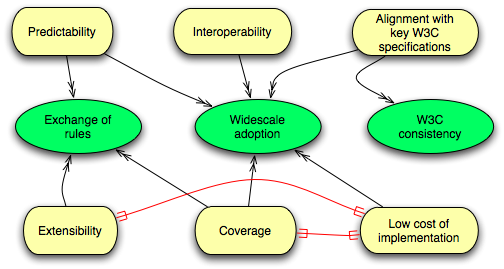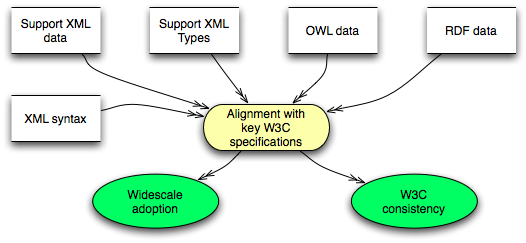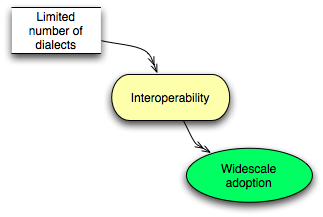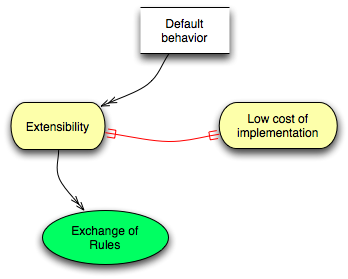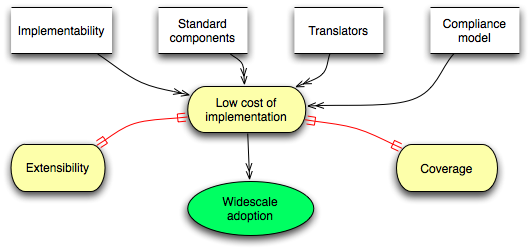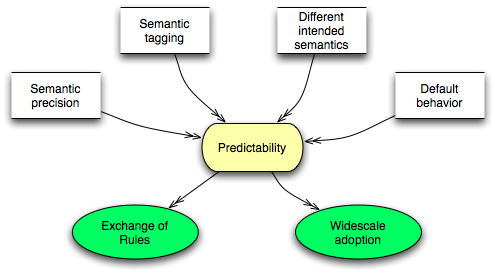Decision support systems aid in the process of human decision making, especially decision making that relies on expertise. Reasoning with rules is an important part of this expert decision making. For complex decision support systems, it is expected that rules will be furnished by a variety of different sources, including ontologies, knowledge bases, and other expert systems. This use case illustrates how the RIF makes it possible to merge rulesets from diverse sources in diverse formats into one rule-based system, thereby enabling inferences that might otherwise have remained implicit.
Medical decision support systems, such as the ones discussed below, might use rules from pharmaceutical knowledge bases, laboratory knowledge bases, patient databases, and medical ontologies. For example, a large amount of information on therapeutic medications (drug taxonomies, indications, contraindications, and clearance times) and diseases (disease taxonomies, etiologies, and symptoms) is contained in existing ontologies such as SNOMED Clinical Terms®. Rules can be used to express therapeutic recommendations, to formulate queries about relevant prescriptions for a patient, and to assess the effectiveness of a treatment.
The following scenario illustrates how rule-interchange would be used in various medical decision support systems to support the following functionalities:
-
Improving situation assessment, e.g., determining when a patient needs to be put on medication, or have his medication switched.
-
Prescribing a course of action, e.g., determining which drug is best for a patient in a particular circumstance.
-
Improving event planning, e.g., determining whether a patient can be scheduled for a procedure given the medication that he is currently taking.
Bob, 62 years old and reasonably healthy, has been going to his internist, Dr. Rosen, for several years for control of his Type II diabetes. Dr. Rosen has been using the AutoDoc system to help him decide when to switch to medications and which drugs to prescribe. The AutoDoc system uses two sources when making its recommendations: a laboratory knowledge base giving particular results for patients and specifying when these results are out of normal range, and a pharmaceutical knowledge base giving guidelines for the use of medications. Automated reasoning with rules from these combined sources is possible if the rules are first mapped to the RIF. Here are two specific examples of such synergistic effects.
This scenario discusses the fictitious expert systems AutoDoc and MEDIC. In the interest of readability and brevity, the information and rules presented in the following scenario may not precisely capture the current state of medical knowledge and best practices in this field, but may be somewhat simplified.
Originally Bob's diabetes was controlled through diet and moderate exercise. In time, however, Bob’s blood glucose level began to rise, even under this regimen. Due to Bob's elevated HbA1c level (which indicates one's average blood sugar level over the last several months), Dr. Rosen prescribed oral medication for Bob. He was forced to change Bob's medication a number of times over the course of a year. He first prescribed Precose, an oral alpha-glucosidase inhibitor, but had to discontinue this medication due to undesired side effects. He then prescribed several sulfonylurea drugs, Micronase and Glucotrol, to no avail. Bob's lab results still indicated an elevated HbA1c level. The following rule from the laboratory knowledge base suggests that Bob's treatment at that time was not effective:
If a Type II diabetes patient's current level of HbA1c is high, then the patient's current treatment is considered to be ineffective.
To deal with this problem, Dr. Rosen was about to prescribe Glucophage (metformin, one of the biguanides) 850 mg, 3 times a day, when as usual, he double checked his prescription with the AutoDoc system. The system, based on the following guidelines from the pharmaceutical knowledge base, informed Dr. Rosen that he should have prescribed an oral bitherapy (two medications, each of which controls blood sugar levels) instead of a monotherapy.
If an oral monotherapy at recommended doses of a sulfonylurea or biguanide, combined with lifestyle changes, is ineffective, then the monotherapy should be replaced by an oral bitherapy.
Based on the recommendation from AutoDoc, Dr. Rosen switched Bob's prescription to Glucophage and Avandia (rosiglitazone, one of the thiazolidinediones).
Bob recently suffered a concussion and has become increasingly forgetful. He went to see a neurologist, Dr. Cervello, who prescribed a contrast MRI (Magnetic Resonance Imaging). When asked about current medication, Bob told Dr. Cervello that he was taking Glucotrol to control his diabetes, forgetting that he had been switched to Glucophage. This was potentially problematic, since Glucophage should not be taken close to the administration of a contrast injection.
Fortunately, when Bob went to the lab to schedule his MRI, the medical receptionist pulled up MEDIC (Medical Event and Drug Interaction Consultant), the hospital’s new automated system, which checks for incompatible medical events and/or drugs (e.g., liposuction scheduled during pregnancy, blood thinners prescribed before surgery, etc.).
MEDIC uses a variety of sources in its reasoning, including:
-
the pharmaceutical knowledge base, described above
-
the patient databases, which gives the patient record, including the medications a patient is currently taking
-
the hospital medical event protocol knowledge base, which details the protocol used for different medical procedures
In this case, MEDIC uses all three sources, and pulls up the following information:
-
Metformin is contraindicated with contrast dye.
-
Metformin is the generic form of Glucophage.
-
Bob is taking Glucophage.
-
The contrast MRI requires as one of its steps injecting the patient with contrast dye.
MEDIC therefore determines that Bob should not be taking the contrast MRI at this time.
For MEDIC to work, the rules from these different sources must be mapped to a unified interchange format.

